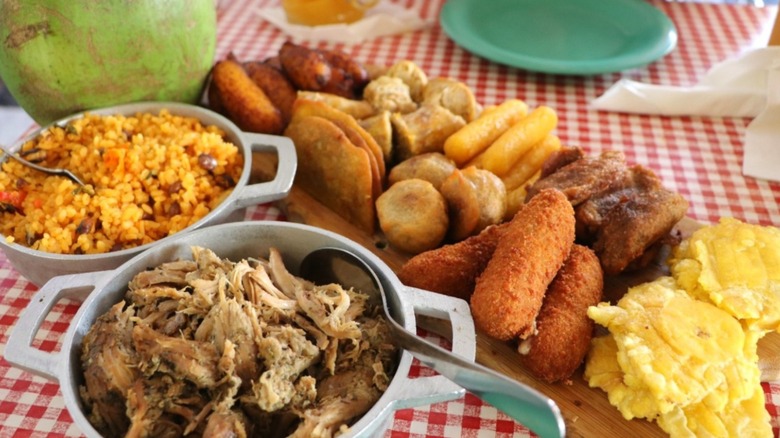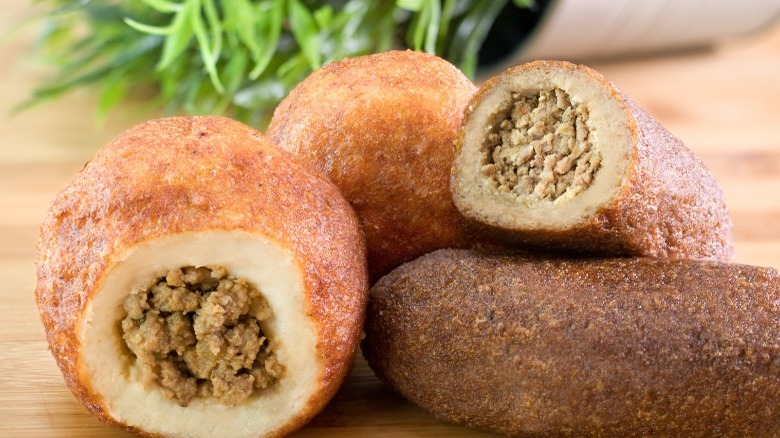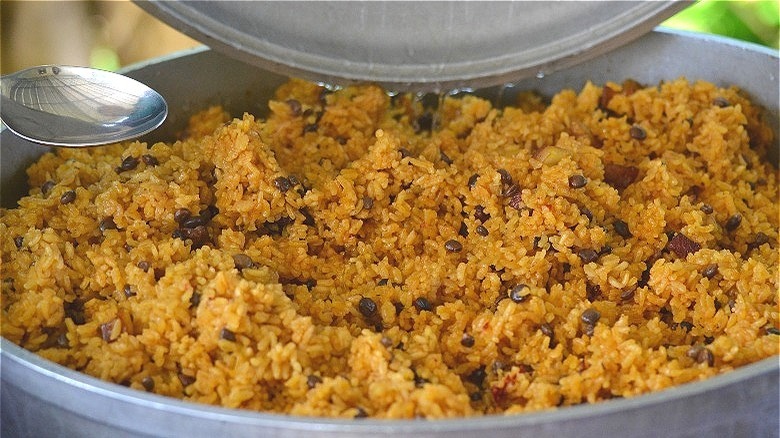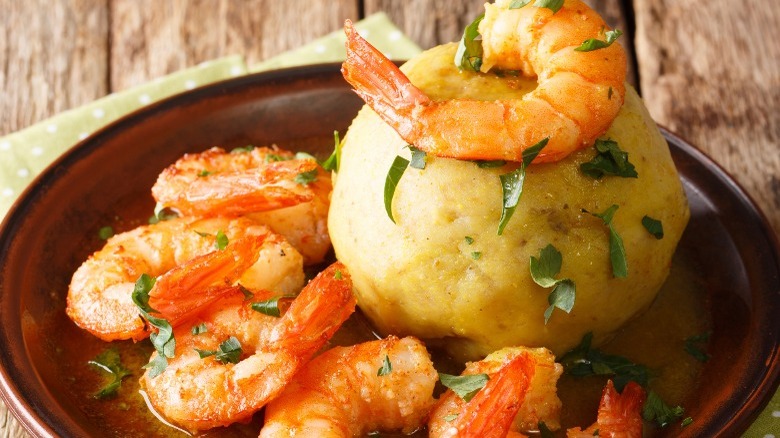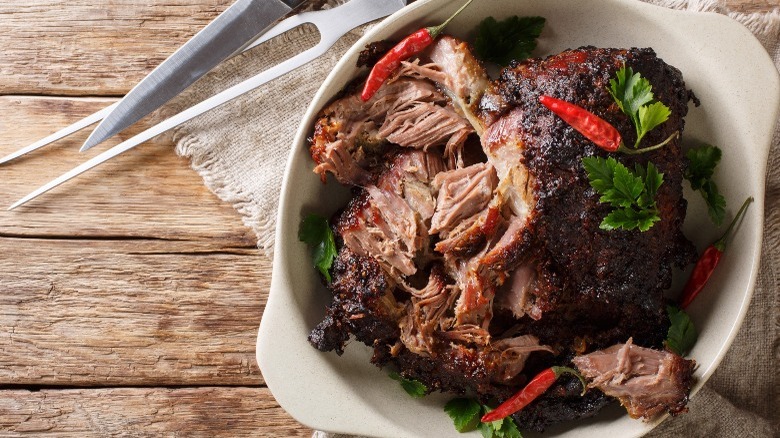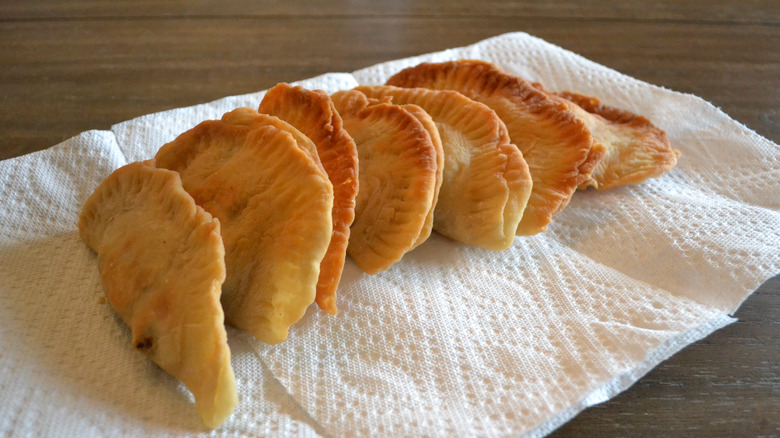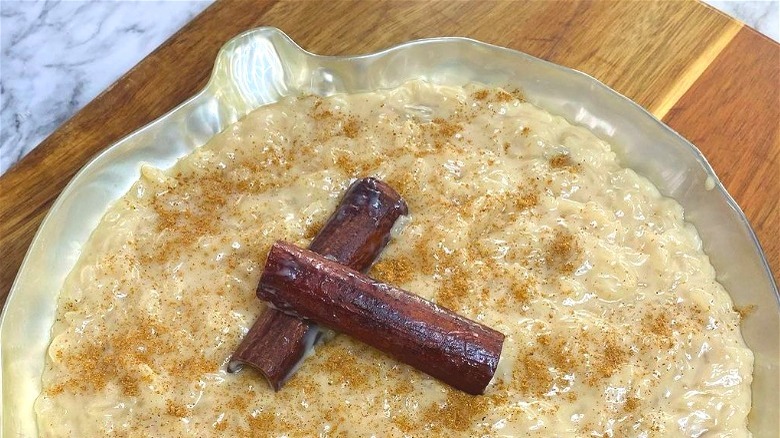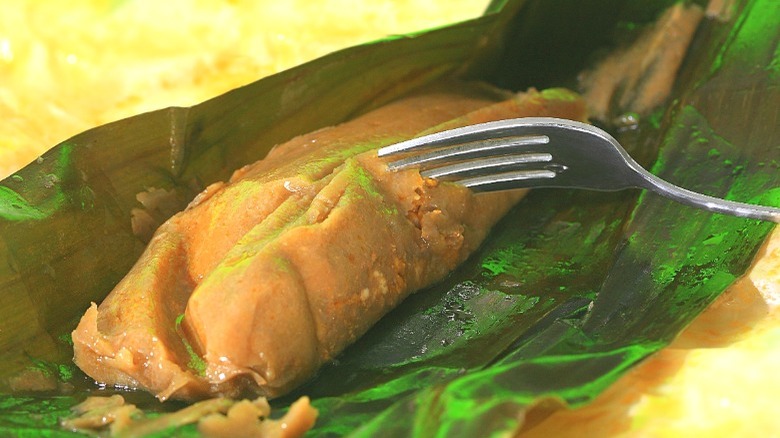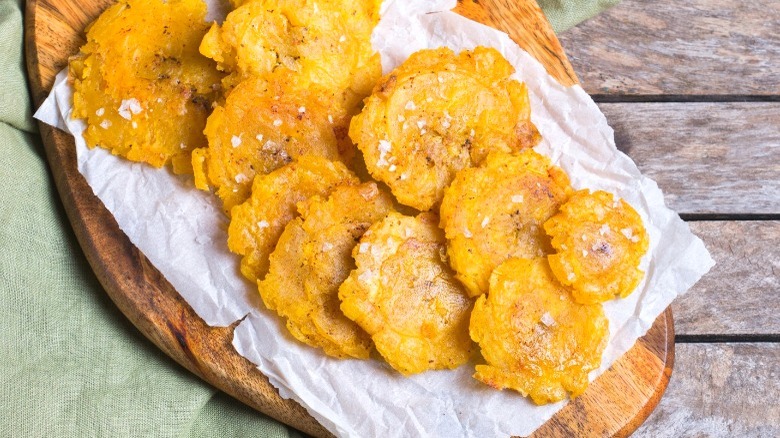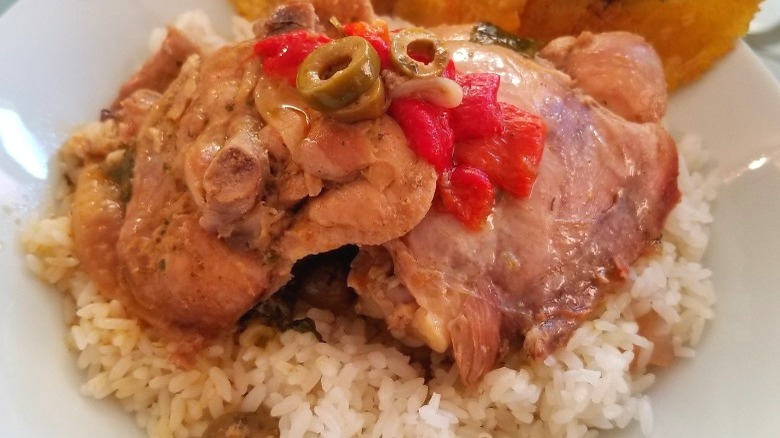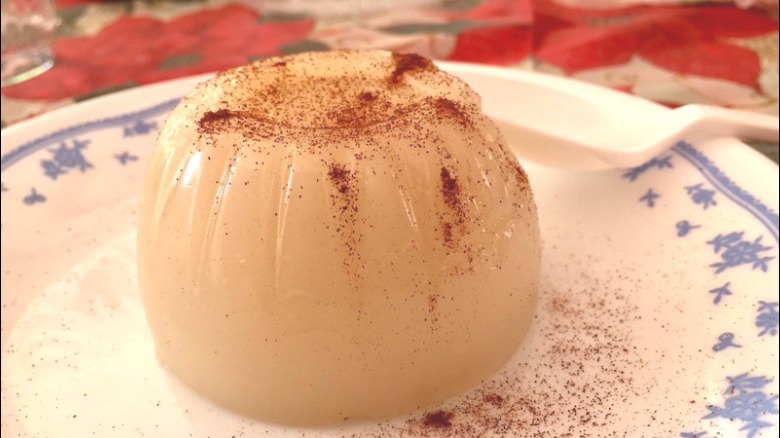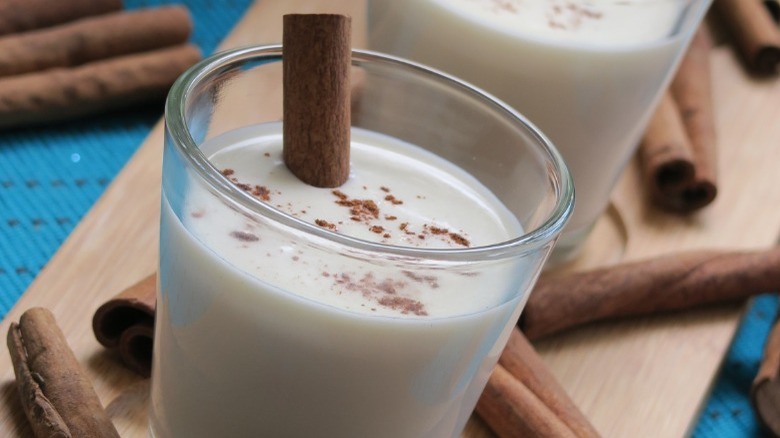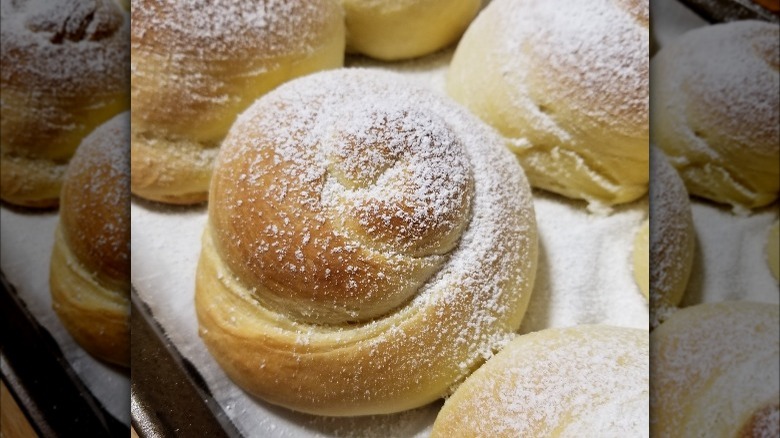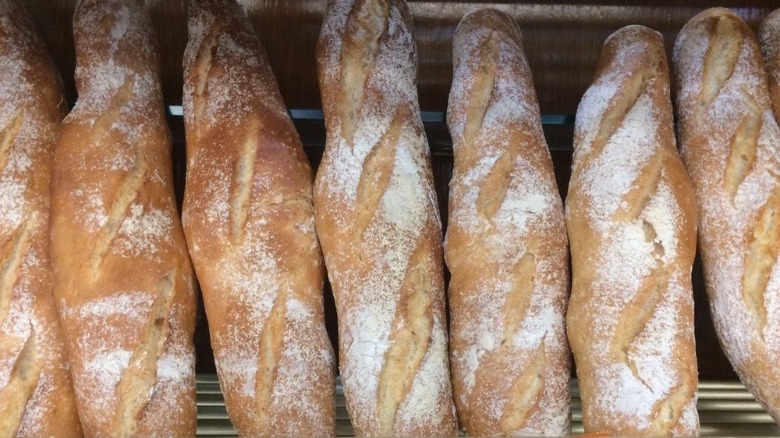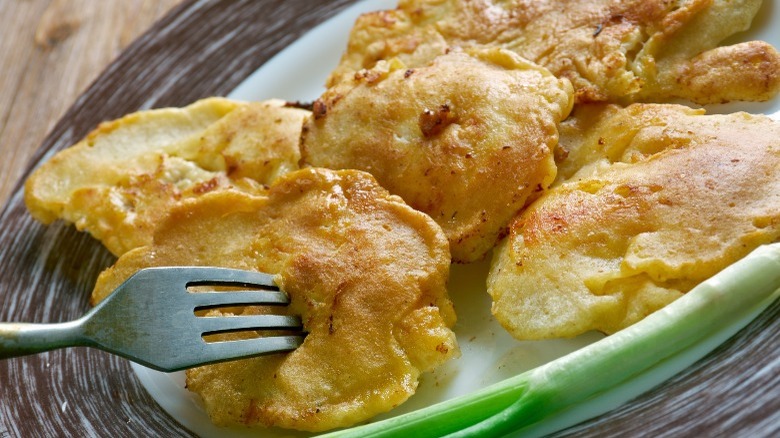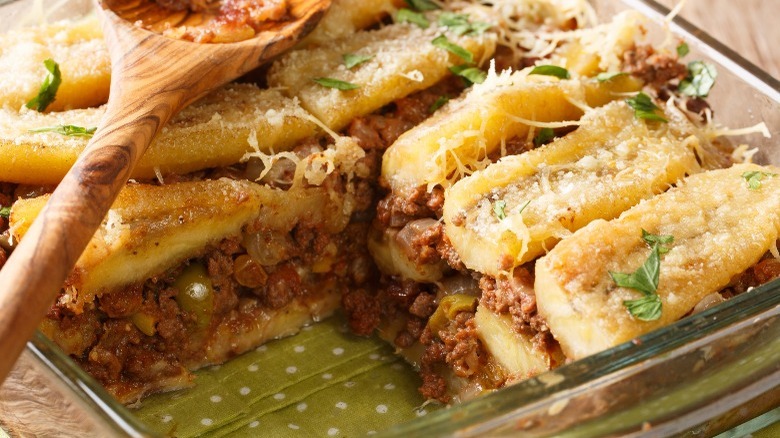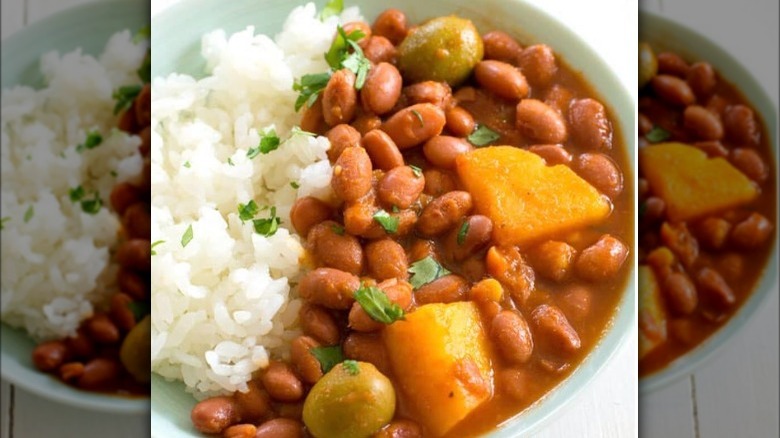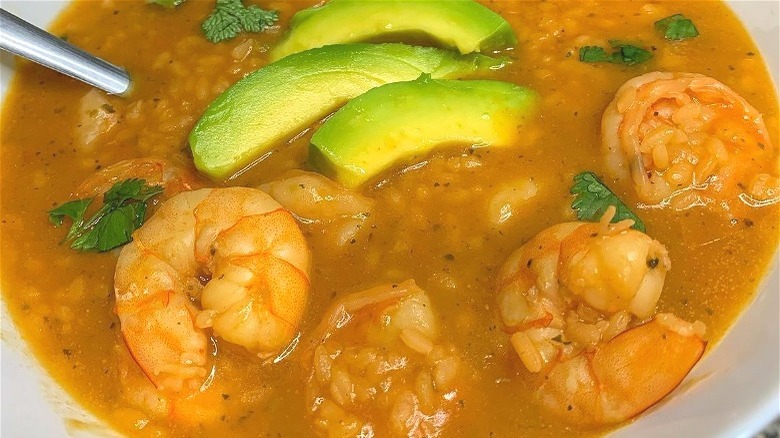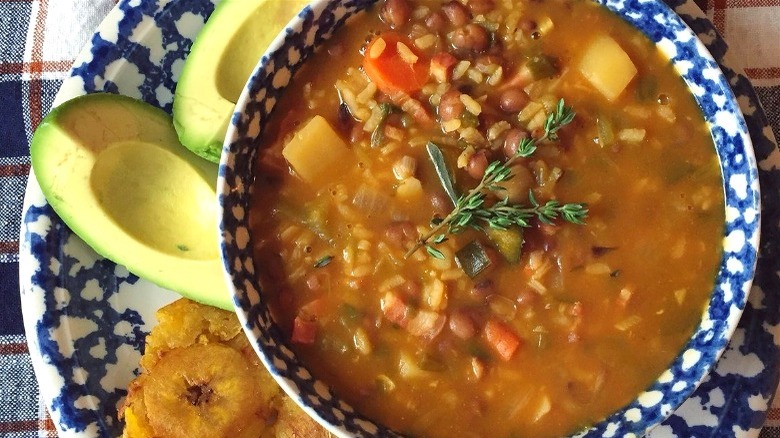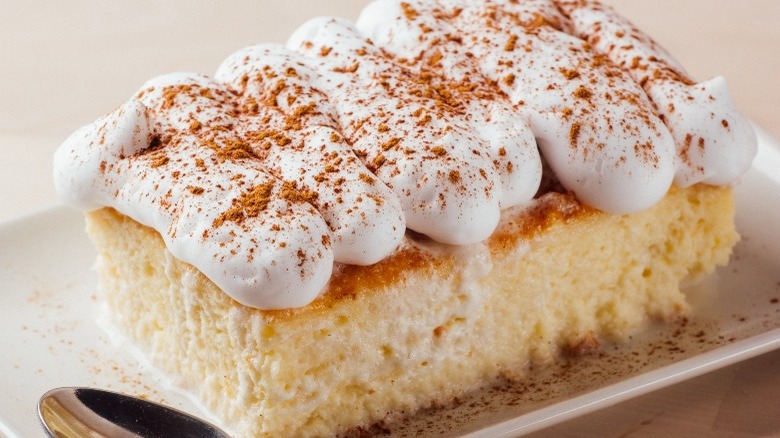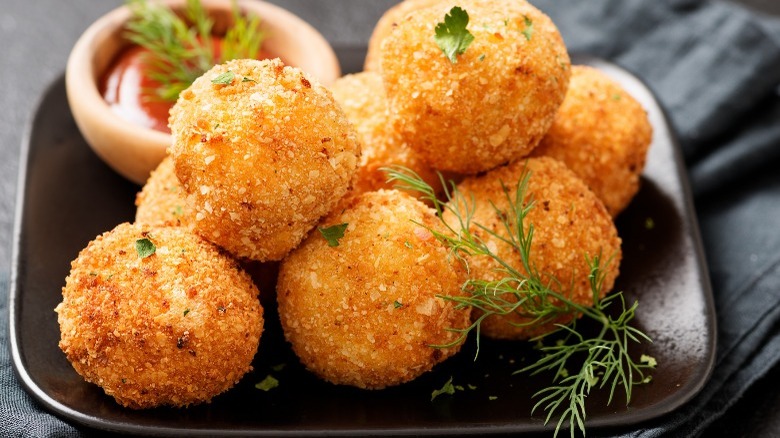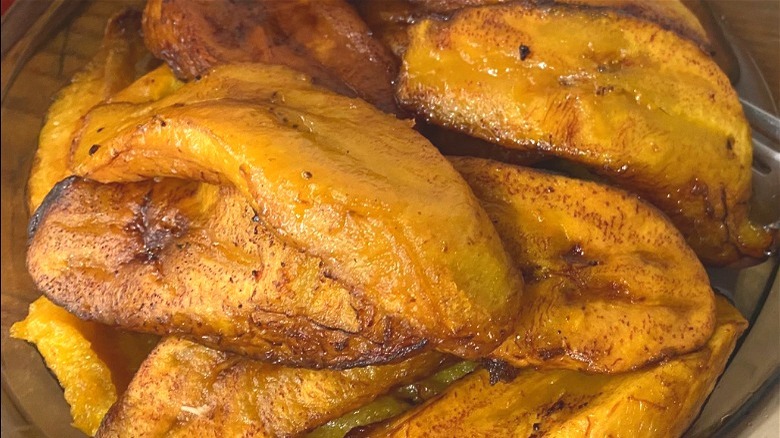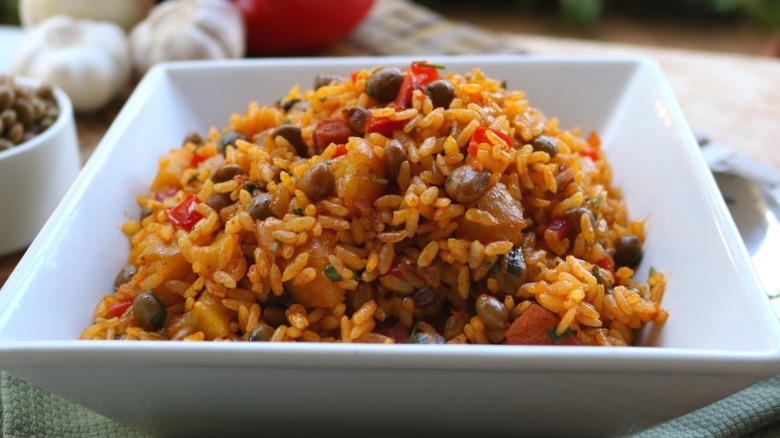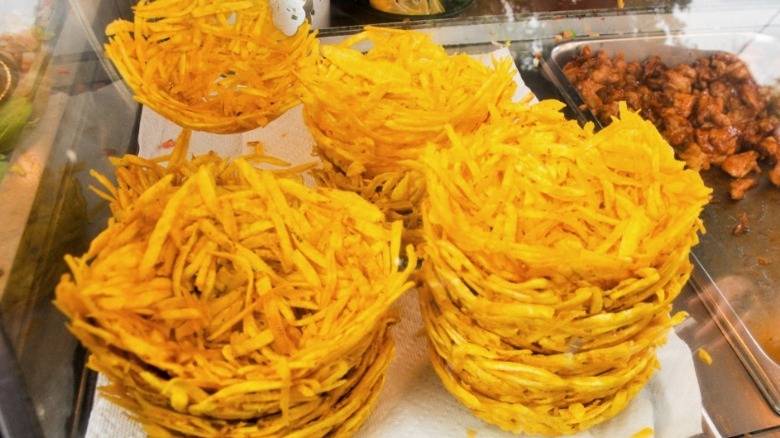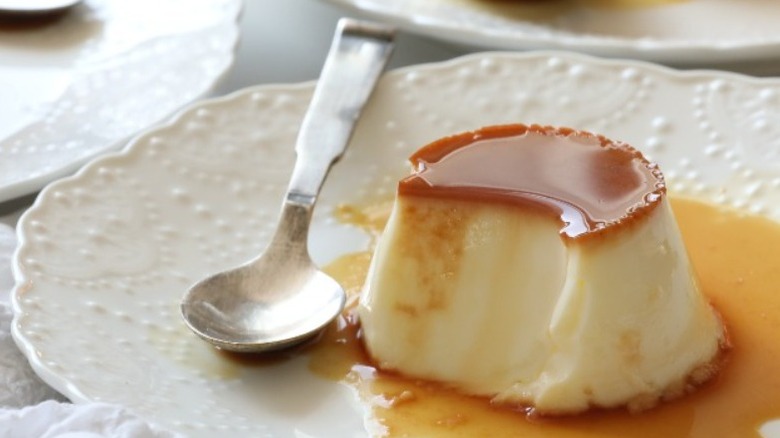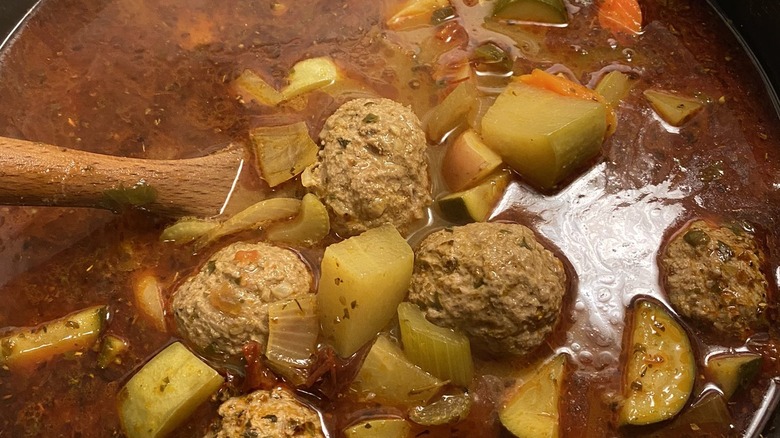26 Puerto Rican Foods You Need To Try At Least Once In Your Lifetime
The food of Puerto Rico is vibrant and far too vast to put into a single box. Its culinary culture, which is a mix of the Taíno native people, African, Spanish, and United States influence, showcases the island's range with many cooking techniques, but there's a particular fondness towards frying. Dishes like rice and beans and empanadas do bear a loose similarity to other styles of Latin American cuisines, but if you look close enough, you'll see that Puerto Rican food proudly draws on the diverse influences that have helped to shape the island cuisine we know today.
Starchy plants like yuca and plantains add structure to some dishes, and seafood, pork, and chicken ensure there's no shortage of proteins. And then there's the frying. Anything from plantains to desserts to fritters may be fried in oil until it has reached that coveted golden brown color. And light, fragrant herbs and spice mixes like sazón and adobo keep Puerto Rican dishes from feeling too heavy.
These dishes are just the tip of the iceberg of Puerto Rico's delicious cuisine, and once you've tasted one you won't regret it.
1. Alcapurrias
Alcapurrias are street food at its finest. At first glance, they're simply a very delicious fritter. But take a closer look and you'll find a culinary surprise. One of the reasons Alcapurrias are so delicious is because they're an explosion of textures. There is a crispy crust, which is made of green plantain and yautía (taro) root, along with a rich filling of ground beef. Some versions are made with yuca (cassava) root and they are just as delicious.
Street vendors often sell these tasty snacks and they are the perfect mess-free vehicle for this mix of crunchy, meaty, savory goodness. With every bite, you'll get some crunch, some rich filling, and depending on whether or not olives were used, a delicious bite of salt.
2. Arroz con gandules
Everyone puts their own spin on arroz con gandules, one of Puerto Rico's national dishes. It is yellow rice and pigeon peas, which are a legume that is popular in Latin American and Caribbean cooking. It's mainly served during the holiday season or prepared for special occasions like weddings and baby showers. How exciting can rice and beans be? Well if you've ever tried this style, you'll know that its popularity lies in its simplicity.
Sofrito, a mixture of peppers, cilantro, onion, and garlic, is often referred to as the most important component in Puerto Rican cooking and when you think about how a dish like rice and beans can be transformed into such a balanced, hearty, and universally enjoyed dish, it makes sense. But watch out, the sofrito can make or break an arroz con gandules and imparts flavor into the rice. Making an arroz con gandules is usually a multi-day affair with different parts taking place on different days but when it all comes together, it's bursting with flavor and one of the most balanced and complete dishes you'll taste!
3. Mofongo
Mashed fried plantains and lots of garlic and spices come together to make one of the heartiest dishes in Puerto rican cuisine. Mofongo is one of those dishes you need to try to imagine. It's nothing like mashed potatoes, and nothing like tostones or other plantain-based dishes.
Green plantains are fried and mashed with garlic, olive oil, salt and pepper, and some broth to soften the mixture. The mashed plantains hold their shape and at this point, they're often shaped into a ball or a bowl and stuffed with meats, vegetables, and sauce. As if it wasn't already delicious enough, mofongo is often then topped with chicarrón (fried pork skin) or served with shrimp dangling off the dish, much like a shrimp cocktail.
4. Pernil
Pork in its various forms is a staple of Puerto Rican cuisine. It's believed to be a remnant of Spanish colonization. And pernil, which is one of the grandest preparations of pork is also a nod to Spanish influence — pernil is a derivation of "pierna" and means leg in Spanish.
Traditional Pernil starts off with bone-in pork shoulder, which is then coated in a marinade of sofrito, salt and pepper, and a host of other optional spices, like lime juice, oregano, adobo, olive oil, and even soy sauce. The pernil is marinaded for at least 24 hours and careful cooks are always sure to get the seasoning deep within the small cuts of the meat for extra depth of flavor.
After the lengthy marinade process, the meat is roasted for at least eight hours. Sure, it's a labor of love to make pernil, but the finished product is more than worth it. The skin is crispy and salty and the meat falls right off the bone.
5. Empanadillas
Empanadillas, little half-moon hand pies stuffed with any number of meat or vegetable fillings, are a staple of Latin American cuisine with slightly different versions coming from many different countries. But you might have noticed a bright yellow hue on these, which comes from Annatto powder (made from seeds of the achiote tree) that is added to the dough.
The Puerto Rican version is said to be smaller than an empanada and is crimped on the edges with a fork and then fried. They're most commonly stuffed with pork or cheese, but along the coast of Puerto Rico, some pastellillos are filled with crab. Sometimes they're even stuffed with sweet fillings like guava and cheese and eaten as a dessert.
6. Arroz con dulce
You'll know it's the holiday season if you smell this sumptuous dessert! Arroz con dulce is a rice pudding-style dish prepared with coconut milk, raisins, ginger, cinnamon, and rum. It's like a sticky, hug in a bowl. Many countries around the world have their own way of preparing a rice pudding, but the coconut milk in the Puerto Rican version adds a tropical flair. This is a common dessert in many bakeries and restaurants so if you see it on a menu, don't hesitate to try it.
This is a Puerto Rican favorite dessert at Christmas and it's the perfect way to ring in the holidays!
7. Pasteles
Eating a pastele is just surprise after surprise. This tamale-esque dish wrapped in banana leaf unfolds (literally) into a savory masa dough that is stuffed with any number of fillings. You might find pork, vegetables, fish, and poultry, which are all very common pastele fillings.
Pasteles are held in high regard as an important and impressive holiday treat and each family will have their own recipe and tradition around making pasteles. They're time-consuming so each family member is given a role that is efficient and makes the process more fun for everyone. If you're able to try one, be sure to savor it because it may taste different the next time you taste it!
8. Tostones
Tostones are crunchy, twice-fried, flattened plantain slices. Yes, it's as simple as that, but that doesn't mean you should doubt the Tostone. They're are eaten all across Latin America and the Caribbean because they're perfect, crunchy bites that they work well as a trusty sidekick with so many different types of dishes. The Tostone is so delicious and simple to make, it's impossible not to love. And if you consider yourself unskilled in the kitchen, tostones are great to try at home because there's only few steps involved.
Across the island, tostones are served as an appetizer or a side dish to many of the stewed dishes because they are the perfect vehicle for dipping into just about anything!
9. Pollo guisado
Chances are, you've had a chicken stew before. But this one gets elevated with Puerto Rican favorites adobo and Sazón. Pollo Guisado is made using bone-in chicken so you end up with a super flavorful broth that thickens into a rich stew over time. Plus the addition of ... wait for it ... olives, which add a nice salty touch. This dish will simmer until the chicken falls off the bone and the vegetables practically melt in your mouth. It's served over a bed of white rice which is the perfect vehicle to sop up all the delicious liquid from the stew.
10. Tembleque
Tembleque, with its smooth texture and coconut flavor, is the perfect end to a filling meal. This wiggly dessert is fun to look at and pronounce but even more delightful to eat. It's a coconut custard, and the name "tembleque" already sounds tempting. This tasty treat has a pudding-like consistency along with an explosive coconut flavor.
Tembleque is a popular Christmas and New Year's celebration dessert and is a combination of coconut cream, coconut milk, cinnamon, sugar, salt, and cornstarch to help the custard-like mold keep its shape. And when prepared properly, will have just the perfect wiggle. The movement of this dessert is so crucial that it's even borrowed its name from the Spanish word for wobbly.
11. Coquito
When the coquito starts flowing, you know it'll be a good time. Not only is coquito the party starter, it's the sign of the holiday season. This drink is often compared to eggnog but there are two distinct differences, egg yolk is not a required ingredient of coquito and there is no sugar added.
Coquito is sweetened from the addition of sweetened condensed milk. It's mixed with coconut milk, cream of coconut, vanilla, clove, cinnamon, and nutmeg. The traditional version does include Puerto Rican rum but it can easily be made alcohol-free for the entire family by just omitting the liquor.
12. Pan de Mallorca
Breakfast is an amazing meal to eat in Puerto Rico, largely due to the pan de Mallorca. Mallorcas are indeed named after the Spanish Balearic island of Mallorca. There, they're named ensaïmadas and they were brought to Puerto Rico by a man named Antonio Rigo in 1900. This sweet, coiled bun is pretty perfect on its own, just sliced into two halves and cooked with butter. Add a cup of morning coffee and voila — a quick and common breakfast!
But as if a light and sweet breakfast bun wasn't delicious enough, the pan de Mallorca can also be served as a breakfast sandwich. The ham and cheese transform this tasty bun into a full-on meal and it's common to find these all across the island.
13. Pan de agua
This unassuming loaf of bread called pan de agua is one of the most popular baked goods on the island of Puerto Rico. It's crusty. It's soft. And if you time it right, it's warm. In Puerto Rico, it's commonly eaten as a breakfast food, but pan de agua is also eaten in many Caribbean countries. The name translates to "bread of water" or "water bread" and as far as breads go, it's on the simpler side to make.
A pan of boiling water sits underneath the bread in the oven as it bakes, imparting moisture and giving the loaf its signature thin and crispy crust.
14. Bacalaitos
Bacalaitos are served across the island but the best are said to be made in the coastal town Piñones. Here the salted codfish fritters are not too thick and they are especially crispy.
They're an all-purpose food eaten with any excuse — on the beach, as an accompaniment to a meal, or at an outdoor festival. But one thing is always the same — they must have a crunch and the inside must have a chewy bite to it.
To make these fritters, salted cod is either soaked in water overnight or boiled several times over to remove some of the salt content. The fish is then shredded and mixed with flour, seasoning, and of course Sofrito. Then a little bit of liquid is added (often milk or water) and the fritters are fried in oil and flattened like a pancake.
15. Pastelón
Known as Puerto Rican lasagna, pastelón is a delicious mash-up of familiar Puerto Rican flavors in a not-so-common casserole format. There are layers upon layers of plantain, meat, and peppers so each bite is kind of like exploring the culture. To make this dish, ripe plantains are peeled and cut into long strips and fried. They'll then be layered in a casserole dish with seasoned meat and a bechamel sauce or tomato-based sauce. Some decisions like whether or not to add green olives are totally up to the chef's personal preferences but no matter what tweaks are made, this is always a crowd favorite.
16. Arroz con habichuelas guisadas
Olives make another guest appearance here but this time alongside fluffy, perfectly cooked white rice and a bean stew. Throw some pumpkin or potato (sometimes, both!) in there and of course, sazón and sofrito and you have arroz con habichuelas guisadas which, if one was forced to pick, might be the most concise representation of Puerto Rico in a single dish.
Arroz con habichuelas is a very common lunch around the island and is often served at cantinas and lunch counters. There are many different takes on this — pink beans, pinto beans, white beans — but no matter how it's cooked, it will satisfy your appetite.
17. Asopao de camarones
If you've tried gumbo, then you'll have an idea of what to expect from a bowl of asopao de camarones. The texture and general flavor profile are quite similar. But don't let that stop you from trying the Puerto Rican rendition which gets its signature flavor from annatto and sofrito.
While there are versions with chicken, chorizo, and other proteins,the shrimp version is slightly lighter and leaves room for other treats. Asopao de camarones looks cumbersome but it actually comes together pretty easily, especially on the island where there's no shortage of fresh seafood available.
18. Asopao de gandules
Here we see yet again the importance of legumes in Pueto Rican cuisine. Asopao de gandules is also gumbo-like dish (similar to the asopao de camarones) but it's definitely more budget-friendly than the seafood version (no shrimp required). Sometimes you'll find turkey necks, bacon or other meat but this is a fun dish for vegetarians to really get a feel for Puerto Rican cuisine.
It's warm and hearty and if you want a little extra starch, don't be shy about enjoying it with a side of tostones!
19. Pastelillos de guayaba
Most people don't need to hear much more than "puff pastry" to whet their appetite, but add in guava paste and cream cheese? That's Pastelillos de guayaba and they are every bit as rich and delightful as they seem ... especially because these golden beauties are also often topped with powdered sugar.
These pastellillos are a very common bakery, or panadería, find. They're easy to spot because of their square shape and are often eaten on the island during breakfast with a cup of coffee.
20. Tres leches
Now you've probably seen tres leches cake because it is a common Latin American dessert that has many (delicious) renditions. Tres leches means three milks, which refers to the condensed, whole, and evaporated milk. There's technically a fourth, which is the whipped cream topping, but who's counting?
Simple vanilla cake is soaked in the three milks but the Puerto Rican version adds cream of coconut and rum for an even richer cake. While it's not quite as popular as some other Puerto Rican desserts, it really ought to be.
21. Rellenos de papa
In Puerto Rican cuisine, potato is often cut up and eaten in soups. It doesn't often take center stage, but in the dish rellenos de papa, potatoes are the star of the show.
Here they are first cooked and mashed, then stuffed with a picadillo mixture — a Puerto Rican specialty of savory ground beef, sofrito, adobo, olives, and spices. Then the balls are fried until they are a golden brown color and have a crispy outer crust. In case you were worried about the picadillo filling outshining the potato shell, no need to worry. The Potato is mashed with butter so it is just as rich and delicious as its filling.
22. Plátanos maduros
The plantain is an amazing fruit because in its less ripe form, it can deliver a savory, potato-like crunch with tostones. But only when allowed to fully ripen does it make a proper maduros. The plantain will look nearly black on the outside ... and that's a good thing.
There are technically only two ingredients needed to make the ever delicious maduros. With very ripe plantains and some butter or oil for frying (just a few minutes on each side), you get delicious sweet maduros to snack on.
They're often served as an easy starter or side dish but they're also featured in some dishes. How could something so simple be so delicious?
23. Momposteao
Don't be fooled ... mamposteao is not just arroz con habichuelas in a different format. While plenty of ingredients overlap, mamposteao is actually a Puerto Rican rice and stew beans dish that served as a way to use up ingredients from the previous day. (Who doesn't love finding creative ways to use leftovers?) As with many Puerto Rican dishes, this one gets its flavor from sofrito, sazón (with Annatto), and adobo seasoning. It's also got a hint of bacon or other meat to provide some smokiness and structure. But the kicker is the sweet plantains that are added for the perfect combination of salty and sweet.
24. Arañitas
It should come as some relief that arañitas, which means "little spiders," does not actually contain spiders. The name is derived from the appearance of little legs sticking out of the finished product. But actually, an arañita is a nest of shredded and fried green plantains that are flavored with garlic and cilantro.
When fried it becomes sturdy enough to dip, which is exactly what you should do if you ever get your hands on arañitas. They're commonly served with a garlicky dipping sauce. You're welcome in advance.
25. Flan de pan de queso
Flan is easy to love. It is the perfect blend of creamy and sweet with an awesome texture to match. In Puerto Rico, flan is a common dessert and is prepared by mixing eggs, sugar, condensed milk, and evaporated milk.
But the simple addition of cream cheese transforms already delicious flan into flan de queso. The end result is similar to a cheesecake and dulce de leche custard mashup. Die-hard flan de queso lovers may also want to look out for flancocho which takes the beloved dessert one step further by adding a layer of vanilla cake.
26. Albondigas
Puerto rican style albondigas are straightforward hearty pork or beef meatballs swimming in a rich tomato-based sauce. These start with a high-quality sofrito of peppers, garlic and onions, and tomatoes to provide a thick base. In general, meatballs scream "cozy comfort food," and these definitely don't disappoint in that department. But the addition of olives sets them apart from other country's meatballs and gives the dish a salty lift.
These albondigas are commonly served as a main dish over rice with some chopped cilantro, but sometimes they're made slightly smaller and served as an appetizer. What a way to start a meal!
